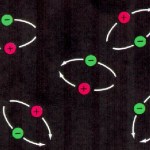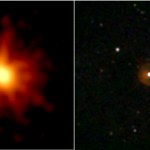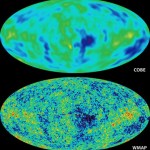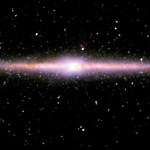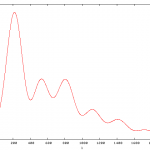Scientific papers
Those of you who are astronomy buffs (or Colbert Report fans) may have heard the news this past January that the Milky Way is just as massive as Andromeda. Colbert even did a special on his show about "America's Galaxy."
Could this be wrong? Could we really be just about the same size? Well, an article came out today by the Italian astrophysicist, Giovanni Carlo Baiesi-Pillastrini, where a brilliant, new technique was used to test this.
Just by watching the tides on Earth, we can figure out what the gravitational tidal forces on our planet are from everything around us, including…
There is a very techincal paper this morning by Martin Bojowald that asks the question, How Quantum Is The Big Bang? Let me break it down for you.
If you took a look at empty space and zoomed in on it, looking at spaces so small that they made a proton look like a basketball, you'd find that space wasn't so empty after all, but was filled with stuff like this:
What are these? They're little pairs of matter particles and anti-matter particles. They spontaneously get created, live for a brief fraction of a second, and then run into each other and disappear. That's what happens on very small…
Nothing gets past you, does it? A scientific paper came out earlier this week, and I took a look at it, sighed, and Jamie asked me, "What?" And I said to her, "When I see bad science, it just makes me a little bit frustrated and sad." Of course, I had no intention to write about it.
But then Starts With A Bang reader Matt emailed me, and writes the following about this press release that he had seen:
You have two explanations for these gravitational waves now and that much I understand. But they make it sound as if symmetry breaking and inflation are competing theories. They aren't, right? Do…
Two summers ago, I was in Les Houches, France, for a summer school that turned out to be one of the best experiences of my life. Seriously, we'd wake up every day and this was the view from the school:
Well, the University/Institution that ran the school sends periodic updates to me. And they linked me to this release. Here's the interesting and (if it's true) sensational claim that the release makes:
Recently, a team of theorists ... performed a new analysis of all available CMB and LSS data including the WMAP and Sloan data and favor an inflation model where exist primordial gravitational…
There are a number of parameters that we deal with in cosmology that have no dimensions; that is, they're just numbers. And yet, there are a remarkable number of coincidences that just "happen to be that way" in our Universe.
Douglas Scott, in this paper, points out some of the more puzzling ones, including:
The age of the Universe (13.7 billion years) is exactly three times the age of the Solar System (4.5 to 4.6 billion years).
The dark matter fraction of the Universe (OmegaDM=0.23 +/- 0.02) is equal to the Helium mass fraction (Yp=0.238 +/- 0.010) of the baryons.
The Hubble constant (H0…
Last week, the brightest gamma-ray burst ever was observed. (See here.) I wanted to know what it was that caused this bright explosion that, despite it being at redshift z=0.94 (or about 7.5 billion light years away), it was visible on Earth with the naked eye!
Well, a scientific paper was written on the observations of this burst, named GRB 080319B, or the second GRB observed on 03/19/08. Let me take you through the highlights. First off, here's what it looked like, in gamma-rays (left) and the afterglow in the optical/UV (right):
When we look from Earth, the faintest objects we can see…
The cosmic microwave background is the radiation left over from the big bang. It's very uniform, 2.725 Kelvin everywhere. We're moving with respect to it, so there's a doppler shift, and we see that as a dipole moment in the Temperature. When we subtract that out, we see variations on the order of 30 microKelvins! WMAP is a satellite (Wilkinson Microwave Anisotropy Probe) that measured these anisotropies, and they just released its year 5 data. First off, with the uniform and dipole parts subtracted out, and with the foreground from the galaxy also taken out, here's the map of the microwave…
It's been a spectacular week for the film space industry, and here at Starts With A Bang!, we've got the recap of all the highlights that you may have missed while watching the countless Oscar montages. Take your time browsing and enjoying this site, and maybe even find out what the question is if 42 is the answer! And now, without further ado, here are the winners from the 43rd Carnival of Space, as chosen by Ethan Siegel, your magnanimous host of this week's Carnival (and check out all previous carnivals here):
Nancy Young-Houser, of A Mars Odyssey, for Stellar Breakthrough Performance…
Alright, startswithabang-ers, Ben, my most avid commenter, saw me online while I was eating breakfast this morning, and pointed me to this new press release. Now, before you get started clicking on everything, the guy who the release is about is Brian Gaensler, who's a really nice guy, lives in Australia, whom I met at the AAS (American Astronomical Society) meeting in Austin, TX last month. Bryan's also brilliant.
Basically, what he did was he said, "well, we know what the rough density of hot gas in our galaxy is, and we can measure the timing of these pulsars to extraordinary accuracy."…
To follow up on the faster than light post here, let's ask another question:
If you can make a way of transferring information that doesn't involve matter, is that information limited by the speed of light?
First off, let's go over what information is, and then we'll talk about how transferring information without matter is even possible. Information is anything that's organized in a meaningful manner. Take a look at the following three sentences:
This sentence contains some information.
Tihs scnnteee cainntos smoe imnfriatoon.
Not a imfro nimsoe mnoisn ctrnsnet sihto.
Each of the three…
Last year, I had just finished my Ph.D. studies, and had moved to Madison, WI to teach introductory physics at the University of Wisconsin. I was working on this paper, and when I submitted it, I got a phone call from New Scientist magazine's space division.
Fast-forward two weeks, and I find this article online, where I got to see my name in print:
Now, scientists led by Ethan Siegel of the University of Wisconsin, in Madison, US, have come up with a new way to potentially reveal blobs of dark matter drifting nearby and perhaps even pin down what it is once and for all.
And I thought to…
Okay, so I got a question from my friend Tamara, who's a high school teacher in my hometown of New York City. It concerns a recent article she read on the front page of the New York Times about something funny that us scientists are calling Boltzmann Brains.
I've read this article three times since it was featured on the front page of the science section in the NYT and I'm still confused about the Boltzmann brain problem, it's (non?)validity, the reason it made it's way onto the front page and whether Emerson's philosophy about imagined worlds came from this...
There's a lot of interesting…
The first serious advocate of modifying Newton's laws instead of postulating unseen (or dark) matter was Moti Milgrom, from whom today a new article appears on the astrophysics preprint archives.
In particular, Milgrom asserts the following:
MOND predictions imply that baryons alone accurately determine the full field of each and every individual galactic object. These predictions are contrary to the expectations in the DM paradigm in view of the following:
a. the haphazard formation and evolution of galactic objects,
b. the very different influences that baryons and DM are subject to during…

